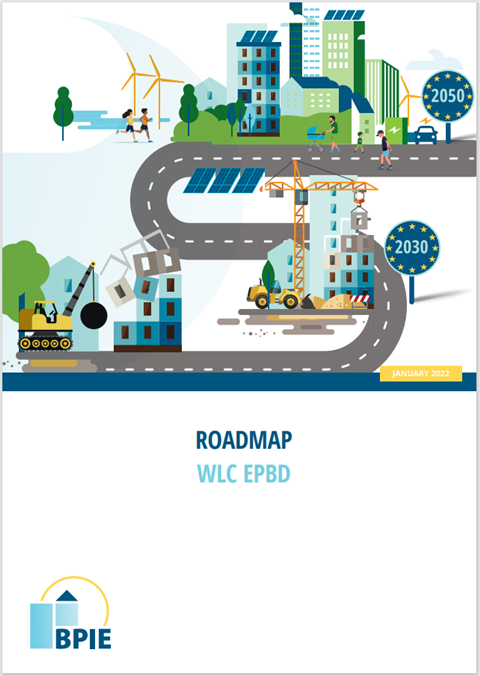A vision for net-zero buildings
22 March 2022
Zsolt Toth of the Building Performance Institute of Europe discusses the need to measure the whole-life carbon emissions of the built environment.
The window of opportunity for significantly mitigating the effects of climate change is closing fast.
While the European Commission (EC) is implementing important legislation, with the aim of lowering the carbon emissions of the built environment, the wheels of politics – at least within democracies – tend to turn slowly.
The Building Performance Institute of Europe (BPIE) is an independent think tank, based in Brussels, established to help the bloc’s policy makers design and implement more sustainable building regulations.
 BPIE’s report is a roadmap for reducing carbon emissions in the built environment (Photo: BPIE)
BPIE’s report is a roadmap for reducing carbon emissions in the built environment (Photo: BPIE)
Initially focused on the energy performance of buildings, the group’s scope has increased to include the whole-life carbon in buildings.
For Europe to achieve carbon-neutrality, emissions must be drastically cut throughout the whole lifecycle of buildings, encompassing all operational and embodied emissions – including those that arise from the construction process.
The EC’s recent proposals, which define a ‘zero-emission building’, also call for the mandatory disclosure of the lifecycle global warming potential of large buildings by 2030.
In the wake of these proposals, the BPIE has released its own ‘roadmap’ – outlining policies that could tackle the lifecycle emissions of buildings, including those resulting from the production, installation, maintenance and disposal of building materials.
Beyond energy performance
One of the lead authors of the BPIE roadmap, Zsolt Toth, spoke to CE about the report and his hopes for its adoption.
“We’ve been concentrating on energy efficiency, energy performance; it’s a big part of our work, a key issue of the past 10 years.
“Now we’re witnessing an expansion of the scope of building-related policies, to go beyond energy performance and towards lifecycle environmental impacts, carbon footprint and so on.
“We’re seeing mostly Western and Nordic countries moving away from energy efficiency as the sole metric, to regulating carbon across the lifecycle [of buildings].”
Toth explains that the regulatory focus within the EU has been largely on energy performance, with the whole-life carbon impact of buildings something of a blind spot, in terms of the EU policy framework.
“We’ve realised this is not enough,” he says, “certainly in the case of new construction.
“For most of the buildings erected today – and the same goes for infrastructure projects, to a large extent – at least half of their carbon footprint is due to these embodied, these ‘hidden’ emissions. By the time the building is handed over for use and operation, a lot of greenhouse gases are already in the air – coming from the materials, coming from the construction processes themselves.
“Going forward, the ratio of embodied versus operational emissions is going to change significantly, so more and more emissions will come from embodied sources, because operational requirements will be very tight and possibly get very close to net zero.”
No simple answers
From here, the next obvious question is why are we not already regulating the whole-life carbon emissions related to buildings and construction?
Toth says, “Embodied emissions are clearly much more difficult to measure than operational emissions.
“It’s not as though you can install a metre when you start construction work, then read the metre to get the carbon footprint of the building. You have to rely a lot on data provided by the designers, the product manufacturers. Today, I think it’s fair to say there’s quite a lot of uncertainty around this. You have to make some assumptions and work with scenarios and you will never have a precise amount for the carbon budget for a project or for a building.”
These do seem like monumental challenges, but Toth insists, “This should not stop us from taking action – there is clearly a question of how much data we need to start effectively regulating against this and checking compliance. That’s the argument we try to make in our report.”
There is a sense of urgency, both in the roadmap report from BPIE and also in the tone adopted by Toth, who says of the current EC proposals, “We are aware the next review is not for five years. We are going to miss the 2050 carbon neutrality target if we don’t take action now.
“I appreciate there are uncertainties to 2050, but I think it’s important to provide that long-term vision, for the market to prepare for this, and if certain things cannot be introduced in the current recast, it’s very important that the trajectory is already being set.
“Climate mitigation is very much time dependent. If we don’t address all sorts of carbon emissions today – or over the next five to 10 years – it will make no sense if we have very efficient buildings in 2050, because we will have already missed our target.
“We think the roadmap provides quite a compelling reason why the policy makers should consider lifecycle emissions.”
 Climate mitigation is time dependent – it will make no sense if we have very efficient buildings in 2050, because we will have already missed our target.” Zsolt Toth, co-author on the BPIE roadmap report
Climate mitigation is time dependent – it will make no sense if we have very efficient buildings in 2050, because we will have already missed our target.” Zsolt Toth, co-author on the BPIE roadmap report
Given the technical, logistical and political challenges surrounding the measurement of whole-life carbon data from the construction industry, it is unlikely that there will be any EU-wide directives on this for some time.
So where do we go from here?
Toth says, “Clearly, more collaboration will be required, but setting a carbon budget for a building project or an infrastructure project sets out clear responsibility and accountability across the various construction and building sector value chains, starting from the commissioning, the design, the product manufacturers, the building use and ending with the decommissioning, reuse, etc.
“You need to have an accounting trail. You need to have not just clear responsibilities of what went into the building, and how certain things have been realised.”
The role of data
As the construction industry edges towards its digital transformation, one wonders how big a part technology will play in aiding the net-zero challenge.
Toth says, “The issue is not really about a lack of data, it’s more the data accessibility and data storage. Accounting for and managing and mitigating for whole-life emissions is a data-intensive undertaking. That means this data will have to be stored in a way that is accessible for various stakeholders.”
Nevertheless, he insists there is an opportunity here to capture relevant data that can be used to optimise the carbon footprint of buildings.
He adds that “One of the main barriers we struggle with when it comes to the sustainability performance of the sector is that it’s not really transparent.”
If it were, though, he says, and if common protocols could be put in place for the measurement of embodied carbon levels, things could progress.
He adds, “If financial regulators will reward this sort of ESG [environmental Social Governance] behaviour by providing preferential treatment for banks who, say, have a green portfolio, that could come with certain financial advantages.
“So, for developers, or building or real estate owners, the message is very simple: green assets are likely to get easier finance or a lower interest rate or preferential financing conditions.”
Asked directly whether he believes the goals set out by the Paris Agreement are still achievable, Toth says, “The window of opportunity is closing. The message is very simple: the urgency of action is there.”
For more information about BPIE and its net-zero roadmap, visit www.bpie.eu






